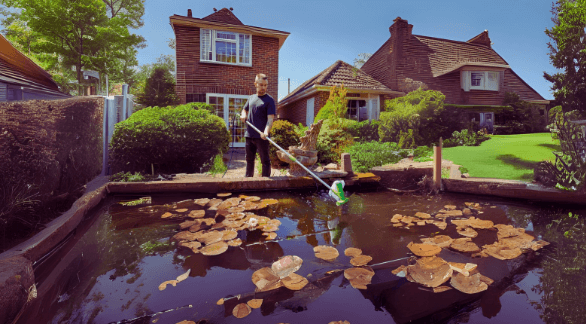The Ultimate Guide to Using a Swimming Pond Vacuum for Clean, Clear Water

A swimming pond is a beautiful fusion of natural design and functional recreation, offering the peaceful charm of a pond with the cool refreshment of a pool. But to keep that water clear, safe, and inviting, ongoing maintenance is essential—especially when it comes to cleaning the pond floor. While biological filtration and plant zones help purify the water, they can’t remove the heavier debris that settles at the bottom. That’s where a Swimming Pond Vacuum becomes an indispensable tool. Specifically designed for this type of environment, a Swimming Pond Vacuum helps remove sludge, leaves, algae, and other organic matter without disrupting the pond’s natural balance. In this guide, we’ll explore how these vacuums work, how they differ from standard pool vacuums, and how to select and use the best one for your swimming pond’s needs.
What Is a Swimming Pond Vacuum?
A swimming pond vacuum is a specialized tool designed to remove debris, algae, and sediment from the bottom and walls of natural swimming ponds. Unlike traditional pool vacuums, which focus on chlorinated, flat-surface pools, these vacuums are built for irregular, natural shapes and eco-friendly water systems.
They help keep the pond floor clean without disturbing the beneficial bacteria and plants that make up your pond’s ecosystem. Whether you’re dealing with leaves, sludge, or silt, a proper vacuum can restore water clarity and prevent buildup that leads to odor or algae problems.
Why Regular Pond Vacuuming Matters
Swimming ponds use biological filtration, meaning no harsh chemicals. While this is great for the environment and your health, it also means organic waste must be removed manually to maintain a safe, hygienic swimming experience.
Without routine cleaning:
- Sludge accumulates, making the bottom slippery and foul-smelling
- Algae grows more quickly, especially during warm months
- Water becomes cloudy, reducing visibility and comfort
- Nutrients increase, inviting mosquito larvae and other pests
Regular vacuuming ensures a balanced ecosystem and maintains the pond’s appeal as a recreational space.
Types of Swimming Pond Vacuums
Choosing the right vacuum depends on pond size, depth, and level of debris. Below are the main types available:
1. Manual Pond Vacuums
These are basic systems with a hose and hand-operated suction mechanism. Ideal for small ponds or spot cleaning, they’re affordable but labor-intensive.
2. Electric Pond Vacuums
Electric models are more powerful and do the heavy lifting for you. They work similarly to a wet/dry shop vac and can handle medium to large-sized swimming ponds.
- Often feature multiple nozzles for different surfaces
- May include two-chamber systems for continuous operation
- Good for removing fine sediment, algae, and sludge
3. Gravity-Fed or Siphon Vacuums
These use water pressure and gravity to create suction. They’re eco-friendly and don’t require power but are slower and best suited for shallow cleaning or small ponds.
Key Features to Look For
When choosing a swimming pond vacuum, consider the following:
- Suction Power: Measured in gallons per hour (GPH). More power = faster cleaning.
- Hose Length: Ensure it can reach the deepest parts of your pond.
- Debris Tank Capacity: Larger tanks mean fewer interruptions.
- Interchangeable Nozzles: For gravel, flat surfaces, or corners.
- Continuous Operation: Dual-chamber models reduce downtime.
- Ease of Use: Look for adjustable handles, wheels, and quick-assembly parts.
- Drainage Options: Some vacuums allow waste to be drained back to the garden or compost pile.
Recommended Swimming Pond Vacuum Models
1. OASE PondoVac 5
- Suction depth: Up to 7 feet
- Dual-chamber design for continuous vacuuming
- Multiple nozzles for different tasks
- Waste discharge hose included
Pros: Powerful, efficient for large ponds
Cons: Premium price
2. Matala Pond Vac II
- Lightweight and user-friendly
- Best for shallow swimming ponds (up to 4 feet deep)
- Auto-fill and drain cycles
Pros: Affordable, simple design
Cons: Not ideal for large debris or deeper ponds
3. Pondovac Classic
- Perfect for medium-sized natural pools
- Comes with various heads for silt, gravel, and flat areas
- Transparent suction tube to monitor debris
Pros: Great performance for its price
Cons: Single-tank system (pauses during draining)
How to Use a Swimming Pond Vacuum Correctly
Step 1: Prepare the Area
- Remove large debris (like branches or heavy leaves) with a net
- Make sure the filter and pump system is running properly
- If possible, switch off the aeration during cleaning to reduce sediment movement
Step 2: Assemble the Vacuum
- Connect hoses and nozzle attachments based on your pond’s floor type (gravel, liner, or concrete)
- Place the unit on stable, dry ground near the pond’s edge
Step 3: Begin Vacuuming
- Start from the shallow end and work your way deeper
- Use slow, steady movements to avoid stirring up debris
- Overlap your paths like vacuuming a carpet
Step 4: Dispose of Waste
- If the vacuum allows, discharge the water into a garden bed or compost heap
- Sludge can be nutrient-rich but should be diluted if used in planting areas
Step 5: Rinse and Store
- Rinse out the tank and hoses after each use
- Store in a dry location to prevent mold and hose damage
Best Practices for Cleaner Swimming Ponds
Vacuuming is just one piece of the puzzle. Combine it with these strategies for optimal results:
1. Maintain a Balanced Ecosystem
Add aquatic plants like water lilies, hornwort, and pickerelweed to absorb nutrients and block sunlight—natural tools to reduce algae.
2. Avoid Overfeeding Fish
Fish waste is a major source of organic buildup. Feed only what they can eat in 2–3 minutes and skip feeding in cooler weather.
3. Use a Skimmer
Install a floating or mechanical skimmer to catch surface debris before it sinks and decays.
4. Test Water Regularly
Use a test kit to check for ammonia, pH, and nitrate levels. This helps prevent imbalance and signals when to clean.
How Often Should You Vacuum a Swimming Pond?
- Spring & Fall: Deep clean before and after swimming season
- Summer: Light vacuum every 2–3 weeks depending on usage and debris
- After storms or heavy winds: Remove new sediment quickly
Over-cleaning can disturb beneficial bacteria, so balance is key. Focus on visible buildup or problem areas instead of vacuuming the entire pond too frequently.
Final Thoughts: Investing in a Swimming Pond Vacuum Is Worth It
Swimming ponds are stunning additions to any outdoor space, offering relaxation and natural beauty. But they require responsible care to stay safe, clean, and enjoyable. A swimming pond vacuum is one of the smartest investments you can make—saving you time, improving water quality, and preserving your pond’s ecosystem.
With the right vacuum and regular maintenance habits, you can enjoy crystal-clear water all season long—naturally and effortlessly.
FAQs
Can I use a regular pool vacuum for my swimming pond?
No. Pool vacuums aren’t designed for sludge, gravel, or natural plant life. Swimming pond vacuums are specifically built for this job.
Do I need to vacuum if I already have a filter system?
Yes. Filters catch suspended particles, but vacuums remove settled debris that filters can’t reach.
How long does vacuuming a swimming pond take?
Depending on size and debris, expect anywhere from 30 minutes to 2 hours.
Is pond vacuuming safe for fish and plants?
Absolutely—just go slowly and avoid sucking up plants or fish by using protective nozzles.
Can I DIY a swimming pond vacuum?
You can build a gravity-fed or siphon vacuum, but for deeper or larger ponds, an electric model is recommended.




